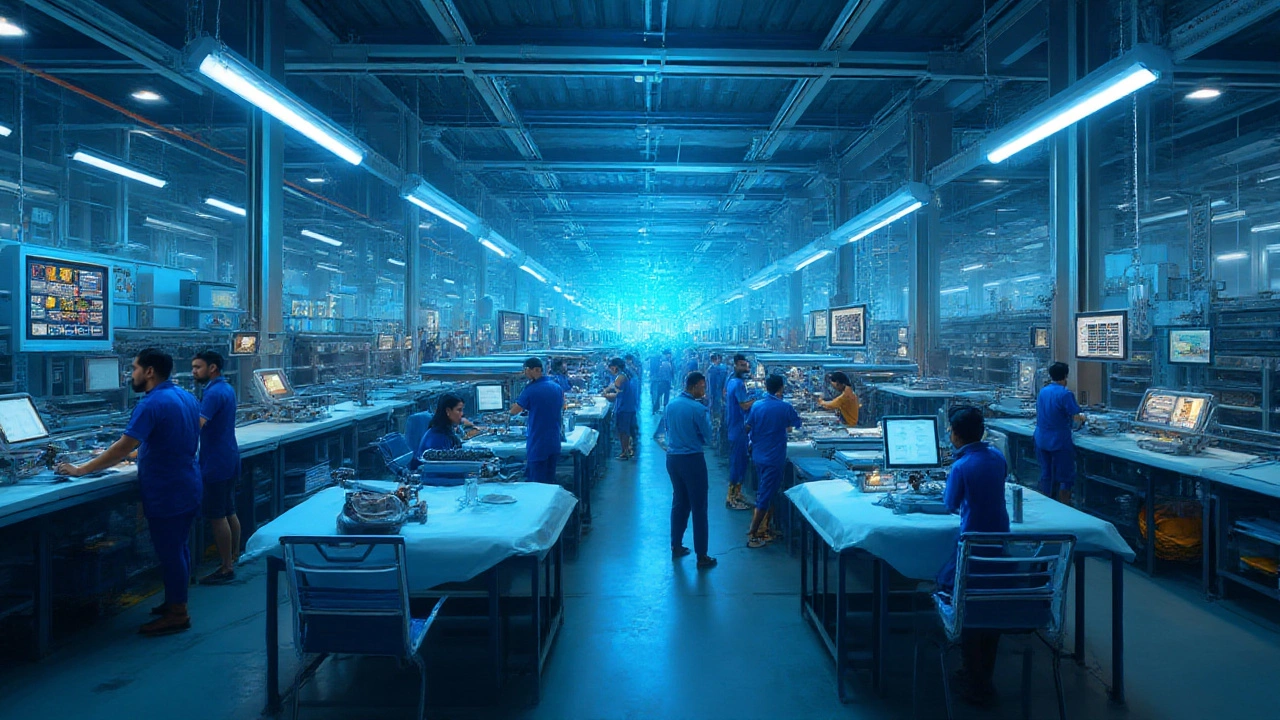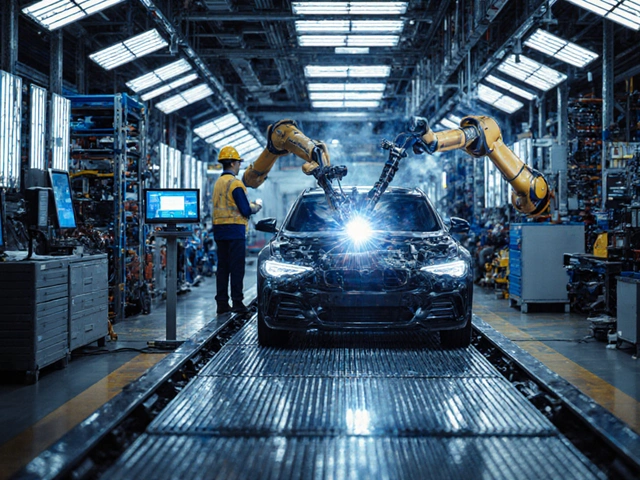Apple isn’t just a consumer favorite—it’s a supply chain legend. Yet, when people talk about the leading manufacturer in the world, names like Foxconn, Toyota, and Samsung muscle their way into the conversation. The answer isn’t as neat as folks might expect. In some corners, people see China as a single, massive manufacturing machine. But when it comes to companies, things get more personal. There’s something almost gladiator-like in the battle for the title of ‘world’s leading manufacturer.’ Scale matters—but so does influence, grip on supply chains, and ability to bounce back from chaos. That’s the real measuring stick.
The Big Picture: Who Is the World's Leading Manufacturer?
Most folks instinctively look to China when thinking about manufacturing giants—and for good reason. The country singlehandedly accounts for about 28% of global manufacturing output. That’s more than the next four countries combined. Still, it’s not a company, it’s an ecosystem, and inside that ecosystem, some real heavy hitters dominate. Take Foxconn for example. Based in Taiwan but running behemoth-sized factories in China (the infamous "iPhone City" in Zhengzhou alone employs more than 200,000 people), Foxconn churns out about 70% of the world’s iPhones. That’s just scratching the surface: it’s the ghostwriter for brands like Amazon, Sony, and Nintendo.
Let’s have a look at the up-to-date leaderboard. Toyota claims the crown for automobile production. In 2024, they manufactured over 10 million vehicles, topping giants like Volkswagen and Hyundai. Meanwhile, Samsung is the undisputed king of electronics manufacturing, from microwaves to microchips. Hon Hai Precision, better known as Foxconn, makes everything from your AirPods to PlayStations. When you pull out a gadget, chances are, at least one piece was put together by Foxconn’s assembly lines.
Here’s how things stack up:
| Company | Main Product | Annual Output (2024) | Home Country |
|---|---|---|---|
| Foxconn (Hon Hai) | Electronics | Over $200B revenue | Taiwan |
| Toyota | Automobiles | 10.5 million vehicles | Japan |
| Samsung Electronics | Semiconductors, Electronics | $225B revenue | South Korea |
| Volkswagen Group | Automobiles | 9.2 million vehicles | Germany |
| General Electric | Industrial Equipment | $85B revenue | USA |
Of course, every chart leaves out the intangibles. For example, Apple might not build anything with its name on a factory, but its influence on contract manufacturing flips the whole game. Their operational playbook—the famous “just-in-time supply chain”—changed how everybody else does business. No one else has industries scrambling each fall to make sure they’re not caught short-handed when the new iPhone drops.
So, which vertical takes the crown? In electronics, Foxconn and Samsung lead. Automotives? Toyota and VW are neck and neck. If revenue is the ruler, Samsung nudges past Foxconn. Yet, Foxconn’s web of clients makes it the behind-the-scenes champion: they’re the manufacturing muscle behind hardware titans that top the headlines.
How These Companies Got So Big—And Stayed There
There’s a story behind every empire, and the world’s top manufacturers weren’t always kingpins. Take Foxconn: what started as a small plastic parts company in the 1970s is now the largest electronics manufacturer on the planet. Bet the founders never pictured their factory city being visible from space. The secret sauce? It’s a mix of relentless innovation, squeezing every drop of value from supply chains, and—let’s be blunt—a willingness to scale up faster than their rivals.
Toyota, on the other hand, rewrote the rules of making things. Their famous “Toyota Production System” (lean manufacturing, kanban cards, zero waste) flipped the industry upside down. The world paid attention. car companies across Detroit, Germany, and South Korea have spent decades trying to copy them. That’s not just a compliment—it shows the depth of Toyota’s impact on global manufacturing.
Samsung’s path is proof that lightning can strike more than once in the same place. Maybe it’s the culture, maybe it’s government policy, maybe it’s caffeine, but somehow, a washing machine and TV manufacturer from the 1960s pivoted into cutting-edge chips and mobile phones. In 2024, Samsung’s semiconductor division alone was responsible for 21% of the world’s microchips. That’s enough to make even Intel sweat.
One big tip from these industry kings: don't overlook diversification. All these names have their hands in plenty of pies. Toyota sells not just cars but forklifts and robots. Samsung isn't just about gadget screens; it makes advanced memory chips used in data centers and AI servers. Foxconn’s attempting to enter the electric car market, and just last year they rolled out their first vehicles targeting Asian and European customers.
There’s also an obsession with automation. Robots are as common as humans in these factories now. In Foxconn’s main plants, at least a third of the production jobs are handled by machines—scary for some workers, but a goldmine for margins.

Major Trends Shaping Global Manufacturing Power
People rarely realize how fast things are changing. Remember the days when "Made in Japan" meant high-quality hi-fi gear? Now it’s “Made in China” on nearly every pair of earbuds, but that tag’s starting to shift. Here’s a wild fact: in 2025, Vietnam and India are both seeing double-digit growth in manufacturing output faster than any of the G7 countries did at their peak. Apple, for instance, now gets about 14% of its iPhones assembled in India, and that’s expected to hit 25% by 2026.
Environmental rules—once brushed off by industry—are now making waves. Europe’s "Green Deal" is setting standards on everything from carbon emissions to recycling electronic junk. Suddenly, manufacturers need to account for their carbon footprints or risk missing out on contracts. Toyota and Volkswagen are pumping billions into electric vehicles as a survival strategy, not just a PR stunt.
Reshoring’s another buzzword not to ignore. After pandemic chaos and endless container delays, brands now hedge their bets. More American companies are investing in domestic factories. A 2024 Deloitte report showed new U.S. manufacturing construction spending hit $189 billion—a record high. This hasn't flipped the world order yet, but it’s putting pressure on China to keep its edge in efficiency and cost.
Tech also refuses to sit still. AI-driven robots, smart assembly lines—these are no longer pipe dreams. As of now, a single Foxconn factory in Shenzhen uses more than 40,000 industrial robots. Samsung is pouring cash into smarter chip plants in South Korea and Texas that run on automation and solar.
- China still grips almost a third of the manufacturing pie, but rivals are closing in.
- Top companies obsess over automation and diversification to keep their crowns.
- Supply chains are bending towards sustainability and resilience, not just low cost.
- Regulations, especially on climate, are moving from Europe to everywhere else.
- Countries like Vietnam and India are picking up pace, taking slices from the old order.
Tips for Navigating the Manufacturing Giants
So what practical wisdom do these megafactories dish out? First off, never put all your eggs in one basket—diversification saves you from nasty surprises like pandemics or political brawls. That’s how Apple and Samsung avoid missing shipments even when whole regions lock down. Second, keep one eye on automation. If robots can take boring, repetitive jobs, let them. This frees up your people for smarter, creative roles, which nobody’s managed to automate so far. As the saying goes at Foxconn: “If it moves, automate it. If it thinks, promote it.”
Staying agile helps too. Toyota built buffers into their supply lines, even before “supply chain disruption” became a boardroom buzzword. This means if one supplier faces a hiccup, another picks up the slack. Small manufacturers can learn from that playbook: always have a Plan B for your key parts. And as my spouse, Isobel, always reminds me, you’re a lot less stressed if you anticipate problems before they land at your door.
If you’re looking to catch trends early, start watching India, Mexico, and Vietnam. These three countries have quietly become the world’s new factories for everything from sneakers to electronics. Nike produces more shoes in Vietnam than China as of last year. And government incentives in India have made it the “fastest-growing mobile nation,” attracting everyone from Samsung to local upstarts like Lava.
Be ready to dance with the regulators. Laws and tariffs can suddenly shift the cost of doing business. Europe’s carbon border tax is already making Asian exporters rethink logistics. Even American companies keep close tabs on trade rules—one wrong turn can wreck margins for months.
Lastly, get into the data. The world's best manufacturers live and breathe by their dashboards—tracking everything from waste rates to downtime to fuel usage. Use digital tools to measure your operation. It’s how giants like Toyota or Foxconn spot a problem before it can snowball. The old-fashioned gut feeling still matters, but numbers don’t lie, and the scale of global manufacturing means tiny mistakes cost millions.
So, who is the leading manufacturer in the world? Foxconn is the muscle, Samsung the brain, Toyota the playbook writer. It depends what you value—output, revenue, innovation, or agility. But one thing’s for sure: these giants aren’t standing still, and the race for the top keeps everyone hustling harder every day.






